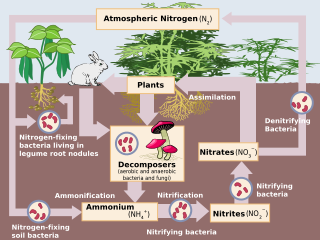Related Research Articles

Hydroxylamine is an inorganic compound with the formula NH2OH. The pure material is a white, unstable crystalline, hygroscopic compound. However, hydroxylamine is almost always provided and used as an aqueous solution. It is used to prepare oximes, an important functional group. It is also an intermediate in biological nitrification. In biological nitrification, the oxidation of NH3 to hydroxylamine is mediated by the enzyme ammonia monooxygenase (AMO). Hydroxylamine oxidoreductase (HAO) further oxidizes hydroxylamine to nitrite.

Nitrification is the biological oxidation of ammonia to nitrite followed by the oxidation of the nitrite to nitrate occurring in separate organisms or direct ammonia oxidation to nitrate in comammox bacteria. The transformation of ammonia to nitrite is usually the rate limiting step of nitrification. Nitrification is an important step in the nitrogen cycle in soil. Nitrification is an aerobic process performed by small groups of autotrophic bacteria and archaea. The two step process was discovered by the Russian microbiologist Sergei Winogradsky in 1890.

The Nitrosomonadales are an order of the class Betaproteobacteria in the phylum "Proteobacteria". Like all members of their class, they are Gram-negative.
Nitrosomonas europaea is a Gram-negative obligate chemolithoautotroph that can derive all its energy and reductant for growth from the oxidation of ammonia to nitrite and lives in several places such as soil, sewage, freshwater, the walls of buildings and on the surface of monuments especially in polluted areas where the air contains high levels of nitrogen compounds.

Nitrosomonas is a genus of Gram-negative bacteria, belonging to the Betaproteobacteria. It is one of the five genera of ammonia-oxidizing bacteria and, as an obligate chemolithoautotroph, uses ammonia as an energy source and as a carbon source in presence of oxygen. Nitrosomonas are important in the global biogeochemical nitrogen cycle, since they increase the bioavailability of nitrogen to plants and in the denitrification, which is important for the release of nitrous oxide, a powerful greenhouse gas. This microbe is photophobic, and usually generate a biofilm matrix, or form clumps with other microbes, to avoid light. Nitrosomonas can be divided into six lineages: the first one includes the species Nitrosomonas europea, Nitrosomonas eutropha, Nitrosomonas halophila, and Nitrosomonas mobilis. The second lineage presents the species Nitrosomonas communis, N. sp. I and N. sp. II, meanwhile the third lineage includes only Nitrosomonas nitrosa. The fourth lineage includes the species Nitrosomonas ureae and Nitrosomonas oligotropha and the fifth and sixth lineages include the species Nitrosomonas marina, N. sp. III, Nitrosomonas estuarii and Nitrosomonas cryotolerans.
Nitrobacter is a genus comprising rod-shaped, gram-negative, and chemoautotrophic bacteria. The name Nitrobacter derives from the Latin neuter gender noun nitrum, nitri, alkalis; the Ancient Greek noun βακτηρία, βακτηρίᾱς, rod. They are non-motile and reproduce via budding or binary fission. Nitrobacter cells are obligate aerobes and have a doubling time of about 13 hours.
Nitrite oxidoreductase is an enzyme involved in nitrification. It is the last step in the process of aerobic ammonia oxidation, which is carried out by two groups of nitrifying bacteria: ammonia oxidizers such as Nitrosospira, Nitrosomonas and Nitrosococcus convert ammonia to nitrite, while nitrite oxidizers such as Nitrobacter and Nitrospira oxidize nitrite to nitrate.
Hydroxylamine oxidoreductase (HAO) is an enzyme found in the prokaryote Nitrosomonas europaea. It plays a critically important role in the biogeochemical nitrogen cycle as part of the metabolism of ammonia-oxidizing bacteria.
Nitrobacteraceae is a family of Alphaproteobacteria. They are gram-negative and aerobic.
SHARON is a sewage treatment process.
Ammonia monooxygenase (EC 1.14.99.39, AMO) is an enzyme, which catalyses the following chemical reaction
Nitrosomonas aestuarii is a gram-negative, aerobe, bacterium from the genus of Nitrosomonas which metabolize ammonia to nitrite for its source of energy.
Nitrosomonas communis is an ammonia-oxidizing, gram-negative, bacterium from the genus of Nitrosomonas which was isolated from the rhizoplane of the reed from a wastewater treatment plant.
Nitrosomonas eutropha is an ammonia-oxidizing, Gram-negative bacterium from the genus of Nitrosomonas.
Nitrosomonas marina is an ammonia-oxidizing, aerobe, gram-negative bacterium from the genus of Nitrosomonas.
Nitrosomonas nitrosa is an ammonia-oxidizing, aerobe, gram-negative bacterium from the genus of Nitrosomonas.
Nitrosomonas oligotropha is an ammonia-oxidizing, aerobe, gram-negative bacterium from the genus of Nitrosomonas which occurs in chloraminated drinking water systems.
Nitrosomonas ureae is an ammonia-oxidizing, aerobe, gram-negative bacterium from the genus of Nitrosomonas.

Nitrapyrin is an organic compound with the formula ClC5H3NCCl3. It is a widely used nitrification inhibitor in agriculture as well as a soil bactericide and has been in use since 1974. Nitrapyrin was put up for review by the EPA and deemed safe for use in 2005. Since nitrapyrin is an effective nitrification inhibitor to the bacteria Nitrosomonas it has been shown to drastically the reduce NO2 emissions of soil. Nitrapyrin is a white crystalline solid with a sweet odor and is often mixed with anhydrous ammonia for application.
Nitrosomonas halophila is an ammonia-oxidizing bacterium from the genus of Nitrosomonas.
References
- ↑ LSPN lpsn.dsmz.de
- ↑ Straininfo of Nitrosomonas halophila
- ↑ George M. Garrity: Bergey’s manual of systematic bacteriology. 2. Auflage. Springer, New York 2005, Vol. 2: The Proteobacteria Part C: The Alpha-, Beta-, Delta-, and Epsilonproteabacteria, ISBN 0-387-24145-0
- ↑ NCBI Taxonomy Browser
- ↑ UniProt
| | This Betaproteobacteria-related article is a stub. You can help Wikipedia by expanding it. |